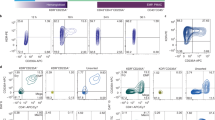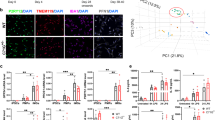Abstract
Mevalonate kinase deficiency is a rare disease whose worst manifestation, characterised by severe neurologic impairment, is called mevalonic aciduria. The progressive neuronal loss associated to cell death can be studied in vitro with a simplified model based on a biochemical block of the mevalonate pathway and a subsequent inflammatory trigger. The aim of this study was to evaluate the effect of the mevalonate blocking on glial cells (BV-2) and the following effects on neuronal cells (SH-SY5Y) when the two populations were cultured together. To better understand the cross-talk between glial and neuronal cells, as it happens in vivo, BV-2 and SH-SY5Y were co-cultured in different experimental settings (alone, transwell, direct contact); the effect of mevalonate pathway biochemical block by Lovastatin, followed by LPS inflammatory trigger, were evaluated by analysing programmed cell death and mitochondrial membrane potential, cytokines’ release and cells’ morphology modifications. In this experimental condition, glial cells underwent an evident activation, confirmed by elevated pro-inflammatory cytokines release, typical of these disorders, and a modification in morphology. Moreover, the activation induced an increase in apoptosis. When glial cells were co-cultured with neurons, their activation caused an increase of programmed cell death also in neuronal cells, but only if the two populations were cultured in direct contact. Our findings, being aware of the limitations related to the cell models used, represent a preliminary step towards understanding the pathological and neuroinflammatory mechanisms occurring in mevalonate kinase diseases. Contact co-culture between neuronal and microglial cells seems to be a good model to study mevalonic aciduria in vitro, and to contribute to the identification of potential drugs able to block microglial activation for this orphan disease. In fact, in such a pathological condition, we demonstrated that microglial cells are activated and contribute to neuronal cell death. We can thus hypothesise that the use of microglial activation blockers could prevent this additional neuronal death.





Similar content being viewed by others
References
Hoffmann G, Gibson KM, Brandt IK, Bader PI, Wappner RS, Sweetman L (1986) Mevalonic aciduria–an inborn error of cholesterol and nonsterol isoprene biosynthesis. N Engl J Med 314:1610–1614
Neven B, Valayannopoulos V, Quartier P, Blanche S, Prieur AM, Debré M, Rolland MO, Rabier D, Cuisset L, Cavazzana-Calvo M, de Lonlay P, Fischer A (2007) Allogeneic bone marrow transplantation in mevalonic aciduria. N Engl J Med 356:2700–2703
Haas D, Hoffmann GF (2006) Mevalonate kinase deficiencies: from mevalonic aciduria to hyperimmunoglobulinemia D syndrome. Orphanet J Rare Dis 1:13
Pfrieger FW, Ungerer N (2011) Cholesterol metabolism in neurons and astrocytes. Prog Lipid Res 50:357–371
Hager EJ, Tse HM, Piganelli JD, Gupta M, Baetscher M, Tse TE, Pappu AS, Steiner RD, Hoffmann GF, Gibson KM (2007) Deletion of a single mevalonate kinase (Mvk) allele yields a murine model of hyper-IgD syndrome. J Inherit Metab Dis 30:888–895
Marcuzzi A, Zanin V, Piscianz E, Tricarico PM, Vuch J, Girardelli M, Monasta L, Bianco AM, Crovella S (2012) Lovastatin-induced apoptosis is modulated by geranylgeraniol in a neuroblastoma cell line. Int J Dev Neurosci Off J Int Soc Dev Neurosci 30:451–456
Marcuzzi A, Tricarico PM, Piscianz E, Kleiner G, Vecchi Brumatti L, Crovella S (2013) Lovastatin induces apoptosis through the mitochondrial pathway in an undifferentiated SH-SY5Y neuroblastoma cell line. Cell Death Dis 4:e585
van der Burgh R, Nijhuis L, Pervolaraki K, Compeer EB, Jongeneel LH, van Gijn M, Coffer PJ, Murphy MP, Mastroberardino PG, Frenkel J, Boes M (2014) Defects in mitochondrial clearance predispose human monocytes to interleukin-1β hypersecretion. J Biol Chem 289:5000–5012
Celec P, Behuliak M (2008) The lack of non-steroid isoprenoids causes oxidative stress in patients with mevalonic aciduria. Med Hypotheses 70:938–940
Ruiz Gomez A, Couce ML, Garcia-Villoria J, Torres A, Baña Souto A, Yagüe J, Vilaseca MA, Ribes A, Aróstegui JI (2012) Clinical, genetic, and therapeutic diversity in 2 patients with severe mevalonate kinase deficiency. Pediatrics 129:e535–e539
Marcuzzi A, Piscianz E, Girardelli M, Crovella S, Pontillo A (2011) Defect in mevalonate pathway induces pyroptosis in Raw 264.7 murine monocytes. Apoptosis 16:882–888
Saijo K, Glass CK (2011) Microglial cell origin and phenotypes in health and disease. Nat Rev Immunol 11:775–787
Wake H, Moorhouse AJ, Nabekura J (2011) Functions of microglia in the central nervous system-beyond the immune response. Neuron Glia Biol 7:47–53
Kettenmann H, Kirchhoff F, Verkhratsky A (2013) Microglia: new roles for the synaptic stripper. Neuron 77:10–18
Chen Z, Jalabi W, Hu W, Park HJ, Gale JT, Kidd GJ, Bernatowicz R, Gossman ZC, Chen JT, Dutta R, Trapp BD (2014) Microglial displacement of inhibitory synapses provides neuroprotection in the adult brain. Nat Commun 5:4486
Correale J (2014) The role of microglial activation in disease progression. Mult Scler 20:1288–1295
Kettenmann H, Hanisch UK, Noda M, Verkhratsky A (2011) Physiology of microglia. Physiol Rev 91:461–553
Li Y, Tan MS, Jiang T, Tan L (2014) Microglia in Alzheimer’s disease. Biomed Res Int 2014:437483
Zhang YH, Chen H, Chen Y, Wang L, Cai YH, Li M, Wen HQ, Du J, An R, Luo QL, Wang XL, Lun ZR, Xu YH, Shen JL (2014) Activated microglia contribute to neuronal apoptosis in Toxoplasmic encephalitis. Parasit Vectors 7:372
Haynes SE, Hollopeter G, Yang G, Kurpius D, Dailey ME, Gan WB, Julius D (2006) The P2Y12 receptor regulates microglial activation by extracellular nucleotides. Nat Neurosci 9:1512–1519
Normand S, Massonnet B, Delwail A, Favot L, Cuisset L, Grateau G, Morel F, Silvain C, Lecron JC (2009) Specific increase in caspase-1 activity and secretion of IL-1 family cytokines: a putative link between mevalonate kinase deficiency and inflammation. Eur Cytokine Netw 20:101–107
Zanin V, Marcuzzi A, Kleiner G, Piscianz E, Monasta L, Zacchigna S, Crovella S, Zauli G (2013) Lovastatin dose-dependently potentiates the pro-inflammatory activity of lipopolysaccharide both in vitro and in vivo. J Cardiovasc Transl Res 6:981–988
Zhu J, Qu C, Lu X, Zhang S (2014) Activation of microglia by histamine and substance p. Cell Physiol Biochem 34:768–780
Riazi K, Galic MA, Kuzmiski JB, Ho W, Sharkey KA, Pittman QJ (2008) Microglial activation and TNFalpha production mediate altered CNS excitability following peripheral inflammation. Proc Natl Acad Sci USA 105:17151–17156
Drenth JP, van Deuren M, van der Ven-Jongekrijg J, Schalkwijk CG, van der Meer JW (1995) Cytokine activation during attacks of the hyperimmunoglobulinemia D and periodic fever syndrome. Blood 85:3586–3593
Cailliez M, Garaix F, Rousset-Rouvière C, Bruno D, Kone-Paut I, Sarles J, Chabrol B, Tsimaratos M (2006) Anakinra is safe and effective in controlling hyperimmunoglobulinaemia D syndrome-associated febrile crisis. J Inherit Metab Dis 29:763
Bodar EJ, Kuijk LM, Drenth JPH, van der Meer JWM, Simon A, Frenkel J (2011) On-demand anakinra treatment is effective in mevalonate kinase deficiency. Ann Rheum Dis 70:2155–2158
Galeotti C, Meinzer U, Quartier P, Rossi-Semerano L, Bader-Meunier B, Pillet P, Koné-Paut I (2012) Efficacy of interleukin-1-targeting drugs in mevalonate kinase deficiency. Rheumatol Oxf Engl 51:1855–1859
Vom Berg J, Prokop S, Miller KR, Obst J, Kälin RE, Lopategui-Cabezas I, Wegner A, Mair F, Schipke CG, Peters O, Winter Y, Becher B, Heppner FL (2012) Inhibition of IL-12/IL-23 signaling reduces Alzheimer’s disease-like pathology and cognitive decline. Nat Med 18:1812–1819
Griffin WST (2013) Neuroinflammatory cytokine signaling and Alzheimer’s disease. N Engl J Med 368:770–771
Liu SH, Yang CN, Pan HC, Sung YJ, Liao KK, Chen WB, Lin WZ, Sheu ML (2010) IL-13 downregulates PPAR-gamma/heme oxygenase-1 via ER stress-stimulated calpain activation: aggravation of activated microglia death. Cell Mol Life Sci CMLS 67:1465–1476
Chen CH, Huang SY, Chen NF, Feng CW, Hung HC, Sung CS, Jean YH, Wen ZH, Chen WF (2013) Intrathecal granulocyte colony-stimulating factor modulate glial cell line-derived neurotrophic factor and vascular endothelial growth factor A expression in glial cells after experimental spinal cord ischemia. Neuroscience 242:39–52
Block ML, Hong JS (2005) Microglia and inflammation-mediated neurodegeneration: multiple triggers with a common mechanism. Prog Neurobiol 76:77–98
Celsi F, Piscianz E, Romano M, Crovella S (2015) Knockdown of MVK does not lead to changes in NALP3 expression or activation. J Inflamm (Lond) 12:7
Acknowledgments
This study was supported by a grant from the Institute for Maternal and Child Health – IRCCS “Burlo Garofolo”, Trieste, Italy (RC 42/2011). We would like to thank Dr. A. Tommasini (Institute for Maternal and Child Health – IRCCS “Burlo Garofolo”, Trieste, Italy) for kindly providing the BV-2 cell line, and Prof. S. Gustincich (Department of Neurobiology, International School for Advanced Studied S.I.S.S.A.-I.S.A.S. Trieste, Italy) for kindly providing the SH-SY5Y cell line.
Conflict of interest
The authors declare that they have no competing interests.
Author information
Authors and Affiliations
Corresponding author
Electronic supplementary material
Below is the link to the electronic supplementary material.
Supplementary Fig. 1
Experimental plan. Microglial cell line (BV-2) and neuronal cell line (SH-SY5Y) were plated alone, in transwell or in direct co-culture. After the first 48 h of culture Lova was added to block the mevalonate pathway and the cell were maintained in culture for further 24 h. Then LPS was administered to stimulate the inflammatory response and cell were culture for 24 h. At the end of incubation period, supernatants were collected for the evaluation of cytokine’s release, while cells were harvested to perform the analysis of programmed cell death and mitochondrial potential assay or treated for immunocytochemistry assay. Supplementary material 1 (PDF 40 kb)
Supplementary Fig. 2
Gating strategy for Programmed Cell Death analysis. Representative dot plot of PCD flow cytometric analysis. A) Debris were excluded from the analysis based on the scatter. B) Microglial cells (BV-2) were identified as CellTrace Far Red DDAO-SE positive cells, while neuronal cells (SH-SY5Y) were unstained. C) and D) Live cells were identified as double negative cells (lower left quadrant); dead cells were identified as Annexin V positive cells (upper + lower right quadrant). Supplementary material 2 (JPEG 210 kb)
Rights and permissions
About this article
Cite this article
Tricarico, P.M., Piscianz, E., Monasta, L. et al. Microglia activation and interaction with neuronal cells in a biochemical model of mevalonate kinase deficiency. Apoptosis 20, 1048–1055 (2015). https://doi.org/10.1007/s10495-015-1139-8
Published:
Issue Date:
DOI: https://doi.org/10.1007/s10495-015-1139-8




